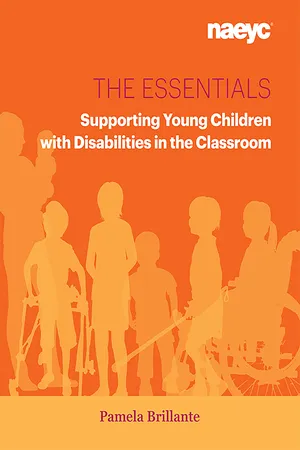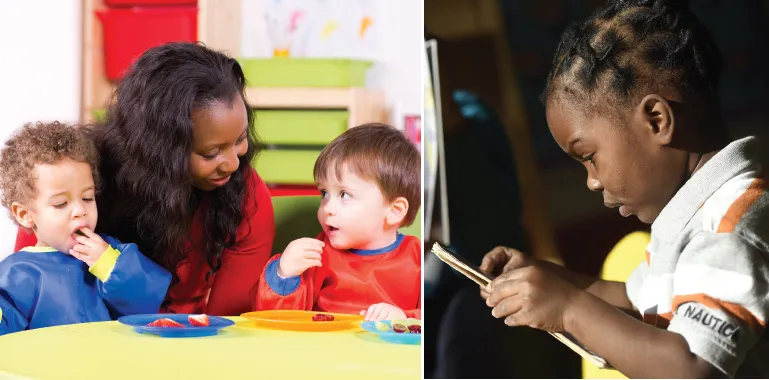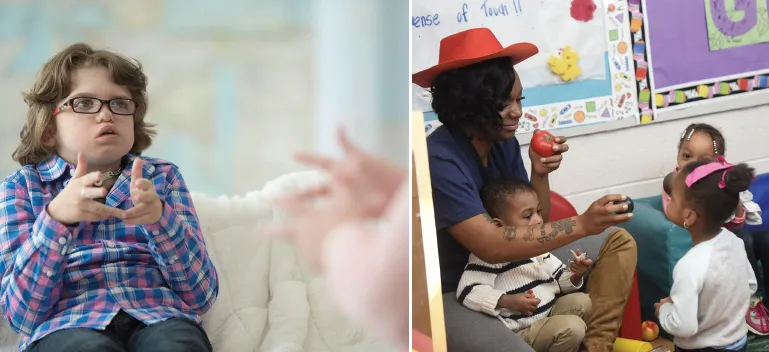
eBook - ePub
The Essentials
Supporting Young Children with Disabilities in the Classroom
- English
- ePUB (mobile friendly)
- Available on iOS & Android
eBook - ePub
About this book
Create an inclusive environment that promotes the success of all young learners
Every year, the number of children with developmental delays or disabilities in early childhood programs and classrooms is increasing. What do you need to know to support them? This guide is filled with practical information that will help educators who work with children ages birth through 8 teach children with disabilities alongside their peers. Learn the essentials of what you need to know:
- What developmental delays and disabilities are
- How special education laws apply to you and your program or school
- The process of referral, assessment, IFSP/IEP development, and service delivery
- Which supports and interventions can help children be successful socially and academically
- How to work with families, special education professionals, and the medical community
- Information about specific disabilities, including speech and language impairments, autism spectrum disorder, physical disabilities, and attention-deficit/hyperactivity disorder
All children thrive in high-quality programs that recognize and support their individual strengths, interests, and needs. Use the information in this book to help children meet their potential.
Frequently asked questions
Yes, you can cancel anytime from the Subscription tab in your account settings on the Perlego website. Your subscription will stay active until the end of your current billing period. Learn how to cancel your subscription.
No, books cannot be downloaded as external files, such as PDFs, for use outside of Perlego. However, you can download books within the Perlego app for offline reading on mobile or tablet. Learn more here.
Perlego offers two plans: Essential and Complete
- Essential is ideal for learners and professionals who enjoy exploring a wide range of subjects. Access the Essential Library with 800,000+ trusted titles and best-sellers across business, personal growth, and the humanities. Includes unlimited reading time and Standard Read Aloud voice.
- Complete: Perfect for advanced learners and researchers needing full, unrestricted access. Unlock 1.4M+ books across hundreds of subjects, including academic and specialized titles. The Complete Plan also includes advanced features like Premium Read Aloud and Research Assistant.
We are an online textbook subscription service, where you can get access to an entire online library for less than the price of a single book per month. With over 1 million books across 1000+ topics, we’ve got you covered! Learn more here.
Look out for the read-aloud symbol on your next book to see if you can listen to it. The read-aloud tool reads text aloud for you, highlighting the text as it is being read. You can pause it, speed it up and slow it down. Learn more here.
Yes! You can use the Perlego app on both iOS or Android devices to read anytime, anywhere — even offline. Perfect for commutes or when you’re on the go.
Please note we cannot support devices running on iOS 13 and Android 7 or earlier. Learn more about using the app.
Please note we cannot support devices running on iOS 13 and Android 7 or earlier. Learn more about using the app.
Yes, you can access The Essentials by Pamela Brillante in PDF and/or ePUB format, as well as other popular books in Education & Early Childhood Education. We have over one million books available in our catalogue for you to explore.
Information
Year
2020eBook ISBN
9781938113857Topic
EducationSubtopic
Early Childhood Education
6 Speech and Language Impairments
Jose is worried about his son, Michael. His second birthday was almost two months ago, and he still isn’t talking much. His older sisters talked early, and once they started talking, they never seemed to stop. Michael is quieter and a bit shy. He communicates mainly by pointing, and his sisters often speak for him.Jose takes Michael to the park to make sure he plays with other children his own age. Jose notices that the other 2-year-olds often use two words together when they talk, and he can understand most of what they say. The other parents at the park tell him not to worry, that Michael will start talking any day now, but Jose is still concerned.At Michael’s next checkup, Jose shares his concerns about Michael’s speech with the pediatrician, Dr. Rose. He tells her that Michael really only uses the words no and cookie, and that sometimes he uses cookie to mean other things—if he is thirsty, sees something else he wants to eat (like french fries), or wants a toy. He does say other words, but he doesn’t use them spontaneously; he only repeats them after someone else says them to him.Jose also explains that Michael does not seem to understand when he asks him to do something that has two steps, like “Put the truck away, and go get your coat.” After listening to Jose, Dr. Rose smiles at Michael and gives him a few directions. Although he readily follows her one-step requests (“Bring me the book, please”), he shows confusion when the doctor gives him a more complex direction (“Bring me the kitty, and then sit down by Daddy”). At the end of the visit, she gives Jose the contact number for the local early intervention program so he can have Michael evaluated.Jose calls right away for an evaluation. A speech-language therapist from the program finds that Michael does have a delay in speech and language, and she begins speech therapy with him twice a week at home. She also offers suggestions for Jose to use during his daily interactions with his son, such as reading with Michael every day and narrating what he and Michael are doing throughout the day. The therapist explains to Jose that it is important to give his son plenty of time to respond to questions and to encourage him to speak, even if it’s only part of a word or phrase.At the therapist’s recommendation, Jose enrolls Michael for a few days a week in a community program for 2-year-olds to give him more social interaction and exposure to language from other children. He shares what he has learned from the therapist with the program teacher, who begins to incorporate some of the same strategies in her daily routines with Michael.Within a few months, Jose notices that Michael is talking more and that it’s a lot easier to understand what he is trying to say. Michael understands more complex language and even holds short conversations with others. Now when everyone tells Jose that his son will be fine, he believes they are right.
Language, whether spoken, written, or signed, refers to words, their meanings, and how we put words together. It consists of receptive language, which refers to understanding the words other people use, as well as expressive language, the ways in which we use words or other means to communicate, like talking, gesturing, or signing. Children with a language disorder may have difficulty understanding what other people say and/or using language to get their meaning across.
Speech is about producing the sounds of language—how a child sounds when he pronounces words and how fluent he is when he talks. Children may have problems with language development, with speech development, or with both. Speech and language disorders may also be present in children with other disabilities, such as intellectual disabilities or autism spectrum disorder.
What Are Speech and Language Impairments?
When a child’s speech and language skills are developing in the expected sequence but at a slower rate, the child is considered to have a speech and language delay. Although a delay may resolve as the child grows, support from a speech-language professional may be useful to help get the child back on the same timeline as other children.
In contrast, an impairment in speech and language involves significant problems in acquiring and using verbal or other communication modes, and comprehension may also be affected. Common disorders include the following (ASHA 2017b):
» Articulation disorders are problems where certain sounds are changed, left off, or added, such as a w in place of an r so the word rabbit sounds like wabbit.
» Stuttering is a fluency disorder in which the child produces an involuntary repetition of sounds, especially initial consonants: “C-c-can I play, too?”
» Childhood apraxia of speech (CAS) is a motor disorder that impacts speech. Children with CAS have a hard time getting their jaw, tongue, and lips to move the correct way to make the sounds and words they want to express. Their speech may sound choppy.

These and other disorders require specific intervention from a speech-language pathologist (speech-language therapist) or other health care professional. Speech and language difficulties account for approximately 20 percent of all children and adults ages 3 through 21 receiving special education services (Kena et al. 2016).
It can be difficult, especially with a very young child, to distinguish between a delay and a disorder, so a therapist may err on the side of caution and choose to use specific interventions rather than wait to see if the delay resolves itself (KidsHealth 2013; NIDCD 2017c).
Possible Reasons for Speech and Language Impairments
A child may be born with a speech or language impairment, or she might develop it later. An impairment is often part of another disability or medical condition, such as Down syndrome, cerebral palsy, cleft lip or palate, or autism spectrum disorder (NIDCD 2017c). A permanent or temporary hearing loss may impact a child’s speech and language skills; if the loss is not addressed or is severe enough, the child will have a difficult time understanding, imitating, and using language.
Other possible causes of speech or language disorders are illness, brain injuries, infections, and environmental factors (Prelock, Hutchins, & Glascoe 2008). Genetic factors may also play a role. In many cases, the cause of a delay or problem in speech or language is unknown.
Impact of Speech and Language Impairments on Development and Learning
In addition to difficulty with spoken language, children with speech and language delays or impairments may have trouble with reading, writing, and learning. The development of sound awareness and the ability to produce and reproduce sounds are the foundational skills a child needs to learn to decode the written word and learn to read (Zembar & Blume 2009).
Speech and language delays and disorders sometimes impact a child’s social and emotional development by inhibiting his understanding of the rules (use and context) of social language, known as pragmatics (McLeod, Daniel, & Barr 2013). This makes it harder for a child to express his ideas, feelings, and personal experiences in a way that is appropriate for his age and to form or maintain close friendships (Wadman, Durkin, & Conti-Ramsden 2011). Behavioral difficulties, such as hyperactivity or attentional difficulties, may also result (Dockrell et al. 2007).
Since communication affects so many areas of a child’s development, it is vital to seek support as early as possible for a suspected problem.
Identifying Speech and Language Impairments
Language is a key area many teachers and parents express concern about. Since all children develop differently, understanding the wide range of speech and language development is important in identifying signs of a delay or disability. According to the American Speech-Language-Hearing Association (ASHA), most children exhibit both receptive and expressive language skills by the age of 1 (2017c).
Language explodes in early childhood!
By the age of
2: Children have single-word vocabularies of several hundred words
3: Children have a word for almost everything they see
4: Most children’s speech can be understood by any adult
5: Most children use past tense correctly
6: Most children ask questions to get information (ASHA 2017c)
The Centers for Disease Control and Prevention (CDC 2017b) has developed a list of important milestones in all areas of development, including speech and language, which can help parents and teachers identify when a child may have a delay or disability. The CDC’s “Learn the Signs: Act Early” campaign stresses that parents should let their doctor know if they are concerned about their child’s speech and language development. Not reaching these milestones by the ages listed, or any loss of milestones already achieved, is something that families need to talk about with a medical professional.
Strategies for the Classroom
Choosing appropriate speech and language interventions for a child is primarily the responsibility of licensed therapists, in consultation with the child’s family and medical providers. In addition to working with the child individually, in the classroom, or in small groups, therapists provide teachers and families with ideas and strategies to support children during everyday activities and routines and to give them multiple ways to express themselves and communicate with others.

Promoting Communication Skills
Look at your everyday classroom routines to become more aware of how your actions and interactions affect children with speech and language disorders. Here are some ways to support children’s communication efforts:
» Give simple, straightforward directions so children can follow them successfully.
» Provide plenty of time for a child to say something. Avoid attempting to help by saying what you think the child is trying to say.
» Ask open-ended questions when reading a story to a child with a speech or language impairment, such as “What do you think about ...
Table of contents
- Cover
- Title Page
- Copyright
- Contents
- About the Book
- Disabilities and Young Children
- Specific Disabilities
- Conclusion
- Glossary
- References
- Resources
- Acknowledgments
- About the Author